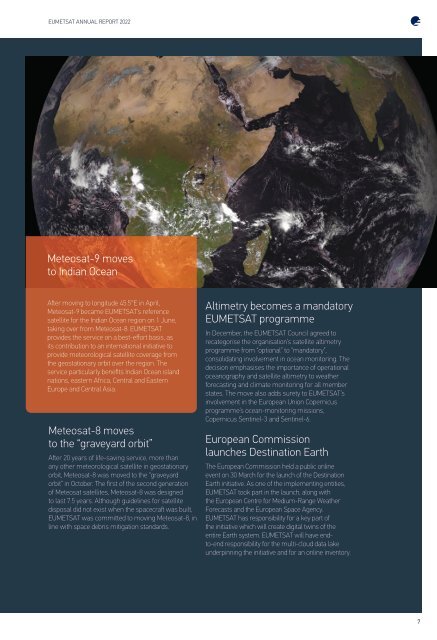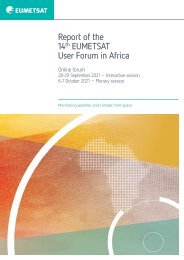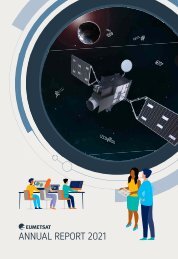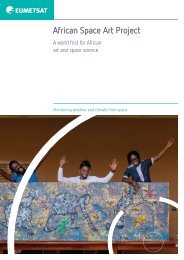EUMETSAT Annual Report 2022
You also want an ePaper? Increase the reach of your titles
YUMPU automatically turns print PDFs into web optimized ePapers that Google loves.
<strong>EUMETSAT</strong> ANNUAL REPORT <strong>2022</strong><br />
Meteosat-9 moves<br />
to Indian Ocean<br />
After moving to longitude 45.5°E in April,<br />
Meteosat-9 became <strong>EUMETSAT</strong>’s reference<br />
satellite for the Indian Ocean region on 1 June,<br />
taking over from Meteosat-8. <strong>EUMETSAT</strong><br />
provides the service on a best-effort basis, as<br />
its contribution to an international initiative to<br />
provide meteorological satellite coverage from<br />
the geostationary orbit over the region. The<br />
service particularly benefits Indian Ocean island<br />
nations, eastern Africa, Central and Eastern<br />
Europe and Central Asia.<br />
Meteosat-8 moves<br />
to the “graveyard orbit”<br />
After 20 years of life-saving service, more than<br />
any other meteorological satellite in geostationary<br />
orbit, Meteosat-8 was moved to the “graveyard<br />
orbit” in October. The first of the second generation<br />
of Meteosat satellites, Meteosat-8 was designed<br />
to last 7.5 years. Although guidelines for satellite<br />
disposal did not exist when the spacecraft was built,<br />
<strong>EUMETSAT</strong> was committed to moving Meteosat-8, in<br />
line with space debris mitigation standards.<br />
Altimetry becomes a mandatory<br />
<strong>EUMETSAT</strong> programme<br />
In December, the <strong>EUMETSAT</strong> Council agreed to<br />
recategorise the organisation’s satellite altimetry<br />
programme from “optional” to “mandatory”,<br />
consolidating involvement in ocean monitoring. The<br />
decision emphasises the importance of operational<br />
oceanography and satellite altimetry to weather<br />
forecasting and climate monitoring for all member<br />
states. The move also adds surety to <strong>EUMETSAT</strong>’s<br />
involvement in the European Union Copernicus<br />
programme’s ocean-monitoring missions,<br />
Copernicus Sentinel-3 and Sentinel-6.<br />
European Commission<br />
launches Destination Earth<br />
The European Commission held a public online<br />
event on 30 March for the launch of the Destination<br />
Earth initiative. As one of the implementing entities,<br />
<strong>EUMETSAT</strong> took part in the launch, along with<br />
the European Centre for Medium-Range Weather<br />
Forecasts and the European Space Agency.<br />
<strong>EUMETSAT</strong> has responsibility for a key part of<br />
the initiative which will create digital twins of the<br />
entire Earth system. <strong>EUMETSAT</strong> will have endto-end<br />
responsibility for the multi-cloud data lake<br />
underpinning the initiative and for an online inventory.<br />
7









